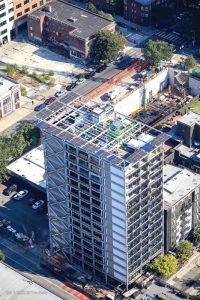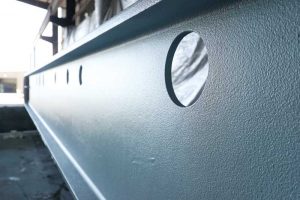
By Max Tritremmel
Architecturally exposed structural steel (AESS) (Figure 1) is a popular design feature that can complement the strength and beauty of steel to other architectural features. However, as a key part of what provides the integrity of the structure, that steel must be protected to ensure it retains its strength in the event of a catastrophic fire.
Traditional fire protection materials were sprayed fire-resistive materials (SFRMs), commonly referred to as cementitious fire protection (CFM), which were not well-suited to complement the beauty of exposed steel. The unsightly finishes often required concealment in the form of drop ceilings, sheetrock, or covers to ensure architects could meet their aesthetic design objectives. The material is also messy when left uncovered, contributing to a large amount of dust in spaces that creates a constant cleaning nuisance, and can quickly clog HVAC filters.
The advent of intumescent fire-resistive materials (IFRMs), which are smooth in appearance, finally allowed for the expression of exposed steel in new and creative ways, and new material innovations continue to support this change. IFRMs allow designers to strip away the unnecessary elements that were common in construction in the last century and create new, simpler buildings—delivered with greater speed, total cost efficiency, and sleeker appearances.
Given the emphasis on beauty with AESS, it is to be noted, no single global standard exists for specifying the finish appearance of the IFRM coating for this element in building design. The American Institute of Steel Construction (AISC) offers a detailed category system for specifying the overall finish quality of exposed steel, based on member visibility, viewing distance, location, lighting, coatings, style, adjacency, and cost.1 However, the AISC guidelines make only minimal reference to IFRM coatings in the AESS category system, generally referring to these coatings as “smooth.” Establishing better guidance for the appearance of IFRMs on exposed structural steel will help the construction and coatings industries deliver better outcomes for AESS.

Current IFRM finish standards
Historically, the fire protection industry has concerned itself with performance defined by code compliance, rather than the finish. Architects and contractors bear the shared responsibility for the look and finish quality of AESS surfaces, as well as compliance with those codes. In the absence of a defined coating standard for the appearance of IFRMs applied to AESS, they have no real objective or straightforward way to define the look of an AESS finish in advance for the building owner to approve.




